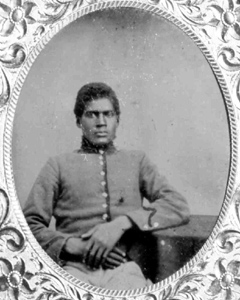
United States Colored Troops
The United States Colored Troops (U.S.C.T.) in Tennessee experienced every facet of war between 1863 and 1865. In the spring of 1863 General Lorenzo Thomas was appointed Commissioner for the Organization of Colored Troops for the Union army in Tennessee. He began actively raising black regiments in Memphis and had 3,000 troops by June. These first regiments were designated by state and race, such as the First Tennessee Volunteers infantry regiment, A.D. (African Descent). But in the spring of 1864 the Union army grouped Tennessee black troops into numbered regiments, such as the Fifty-fifth U.S.C.T. By war’s end, Thomas’s organization had raised nearly 24,000 black troops from Tennessee and other states, filling twenty-two infantry regiments and eight artillery units.
Black troops contributed in a variety of ways. They met the army’s occupational and logistical needs by monitoring conquered territory, watching white Southerners, and assisting in the upkeep of contraband camps. Initially fearful of allowing black troops in battle, the Union army employed them as laborers, construction workers, and guards. U.S.C.T. regiments supervised black women and children crowded into disease-ridden camps outside Tennessee cities. They garrisoned forts in Tennessee, north Alabama, and north Georgia, and guarded prisoners of war. They helped recruit additional black troops. They built fortifications in Middle and West Tennessee, foraged, and performed an array of menial tasks. The U.S.C.T. guarded railroads from guerrilla raids; this duty, in fact, introduced Tennessee black troops to combat.
In December 1863 at Moscow, Tennessee, the Sixty-first U.S.C.T. caught General Stephen D. Lee’s Confederate cavalry trying to rip up the railroad near the Wolf River. A fight began, and the Sixty-first impressively repulsed Lee’s troops. Certainly the most infamous battle waged by the U.S.C.T. occurred at Fort Pillow on April 12, 1864. Confederate General Nathan Bedford Forrest invaded West Tennessee and surrounded the Mississippi River fort. Forrest’s troops numbered three times the garrison of approximately 560 men. When the Confederate call for surrender was refused, Forrest’s troops stormed the ramparts, entered the fort, and massacred Union troops as they tried to surrender. Blacks incurred casualties of more than 60 percent, most of whom died. The Fort Pillow massacre galvanized the U.S.C.T resolve to fight their way to freedom and stigmatized Forrest.
For the rest of 1864, the U.S.C.T., namely those regiments stationed in Memphis, fought alongside their white comrades in skirmishes against Forrest’s cavalry and helped harness the general’s raiders. From June to November, the U.S.C.T. participated in several engagements in Mississippi and Alabama in pursuit of Forrest. At Brice’s Crossroads and Tupelo, Mississippi (June-July), Athens, Alabama (September), and Pulaski, Tennessee (September), U.S.C.T. soldiers encountered Forrest; with each engagement their combat ability improved. At Pulaski, the Fourteenth U.S.C.T. repulsed Forrest’s Confederates and gained redemption for the earlier massacre. In December 1864 the U.S.C.T. fought in heavy combat alongside white Union troops at the battle of Nashville, where they were credited with helping to ensure victory by repelling the Confederate charge on Overton Hill.
Some U.S.C.T. regiments mustered out of service as early as April 1865, while others continued in uniform until April 1866. They conducted mostly garrison and police duties in Memphis, Chattanooga, Knoxville, and Nashville, where black populations were quickly rising as a result of the exodus of former slaves into urban areas. When blacks in uniform demonstrated a pride in their service that white Tennesseans considered “uppity,” violence erupted. Memphis experienced the most serious incident in early May 1866, when a two-day riot left 123 casualties, including 46 dead African Americans.
Nearly 24,000 men of color served in the Union army stationed in Tennessee and suffered almost 4,500 casualties. They persisted against ideas of inferiority professed by Southerners as well as some white Union commanders. Black troops feared mistreatment, or even death, if captured and proved to themselves and their white commanders that they were fighters. Their role in Tennessee during the Civil War should be recognized as indispensable.
Suggested Reading
Richard L. Fuchs, An Unerring Fire: The Massacre at Fort Pillow (1994); Bobby L. Lovett, “The West Tennessee Colored Troops in Civil War Combat,” West Tennessee Historical Society Papers 34 (1980): 53-70; Kenneth B. Moore, “Fort Pillow, Forrest, and the United States Colored Troops in 1864,” Tennessee Historical Quarterly 54 (1995): 112-23



